Abstract
Claims that labial infiltration of the local anesthetic articaine HCl (Ultracaine DS) results in anesthesia of mandibular pulpal as well as maxillary and mandibular lingual soft tissue have never been scientifically substantiated. The aim of this investigation was to evaluate these claims, by comparing articaine to a standard anesthetic, prilocaine HCl (Citanest Forte). To investigate this, a double blind, randomized study was conducted in healthy adult volunteers. In each volunteer, the ability to induce maxillary and mandibular anesthesia following labial infiltration with articaine was compared to prilocaine given contralaterally. Anesthesia was determined by measuring sensation to electrical stimulation at the tooth, labial and lingual soft tissue for each of the 4 non-carious, non-restored, canines. Results showed that mandibular canine pulpal anesthesia had a success rate of 65% for articaine and 50% for prilocaine. Success rates for palatal and lingual anesthesia averaged 5% for each agent. As determined by chi-square analysis, no statistically significant differences were found between articaine and prilocaine for any tissue at any of the 6 sites (P greater than 0.05). A time-course assessment also failed to demonstrate a difference between the two drugs. Therefore these data are not consistent with superior anesthesia efficacy being produced by articaine at any site, including the mandibular pulpal, lingual or maxillary palatal tissues, in the canine teeth studied.
Full text
PDF
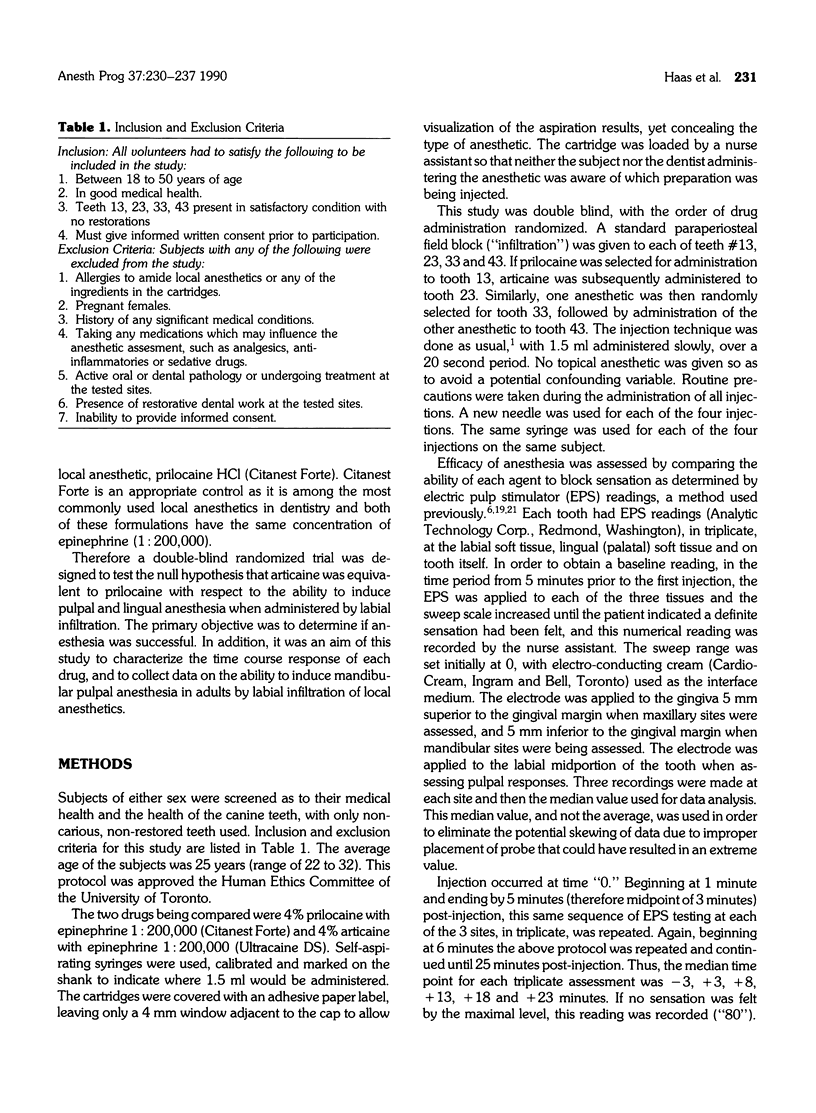
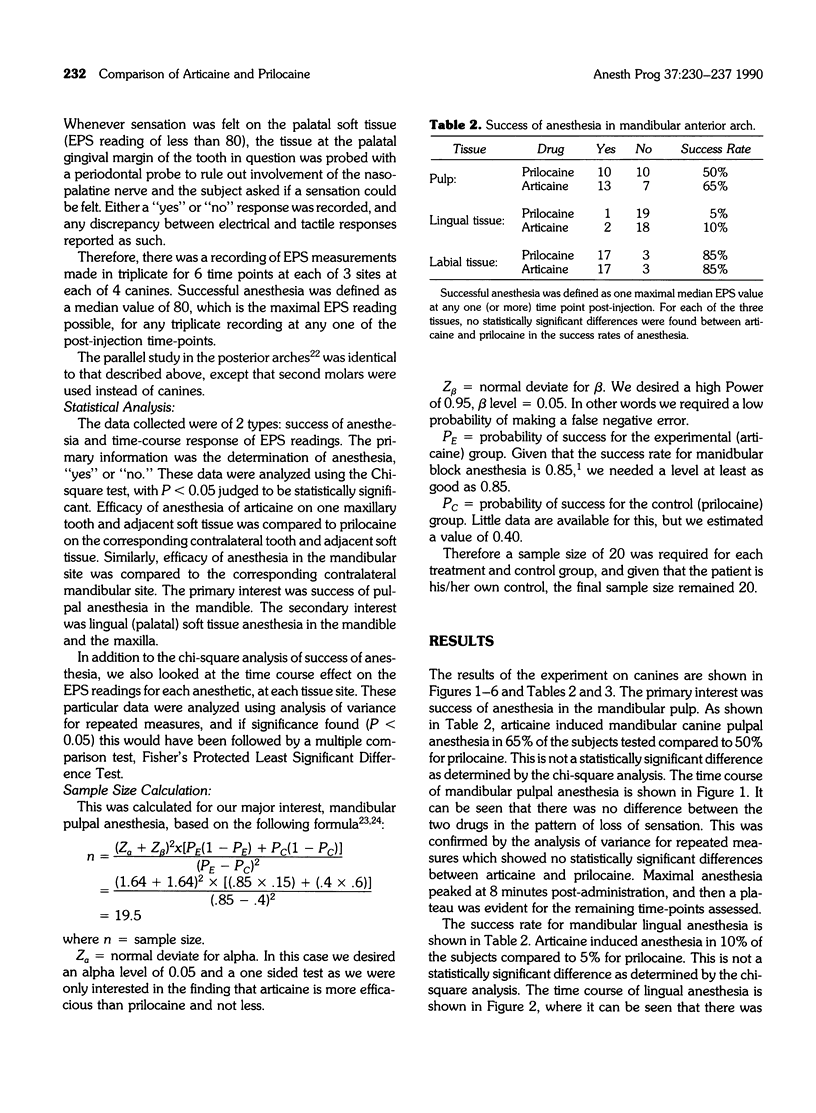
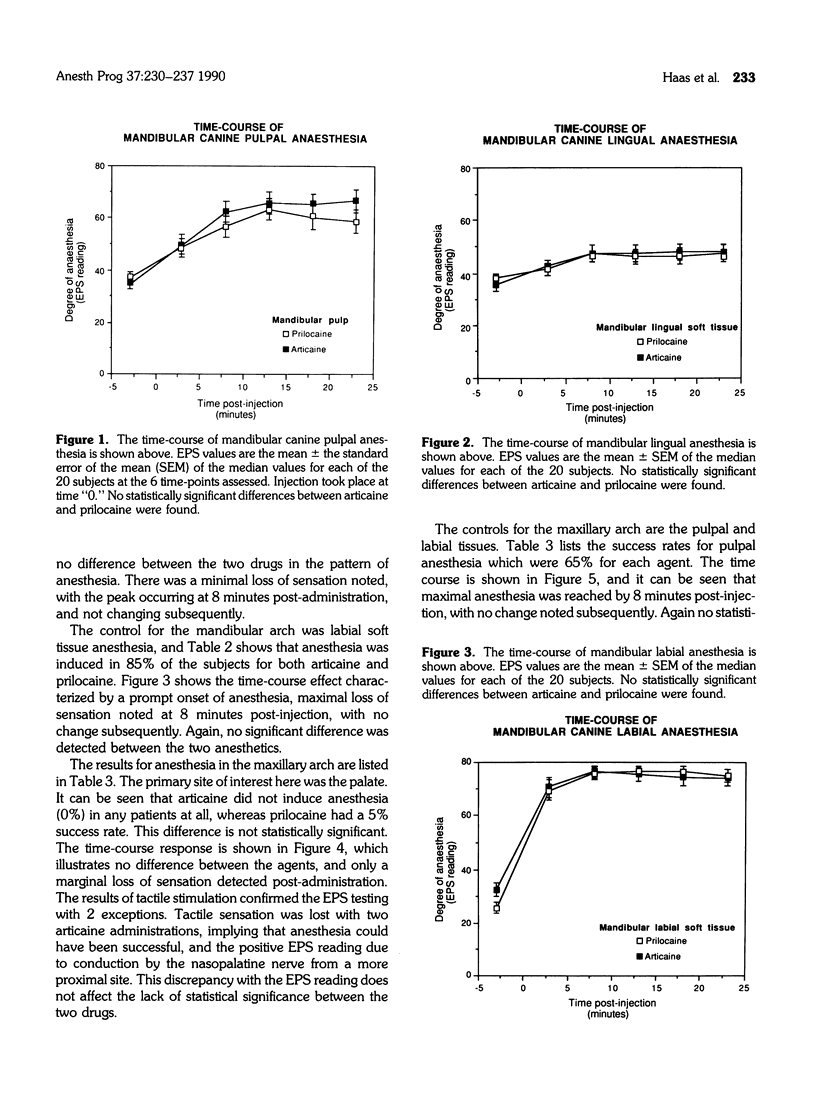
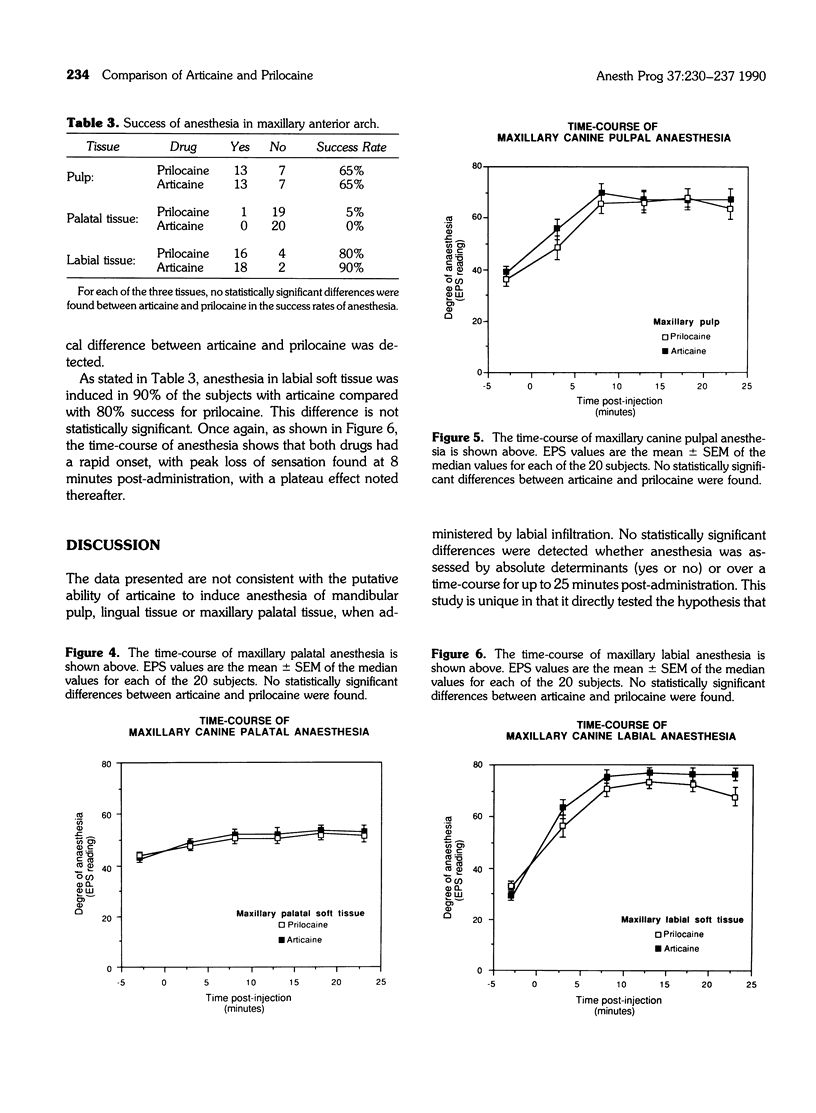

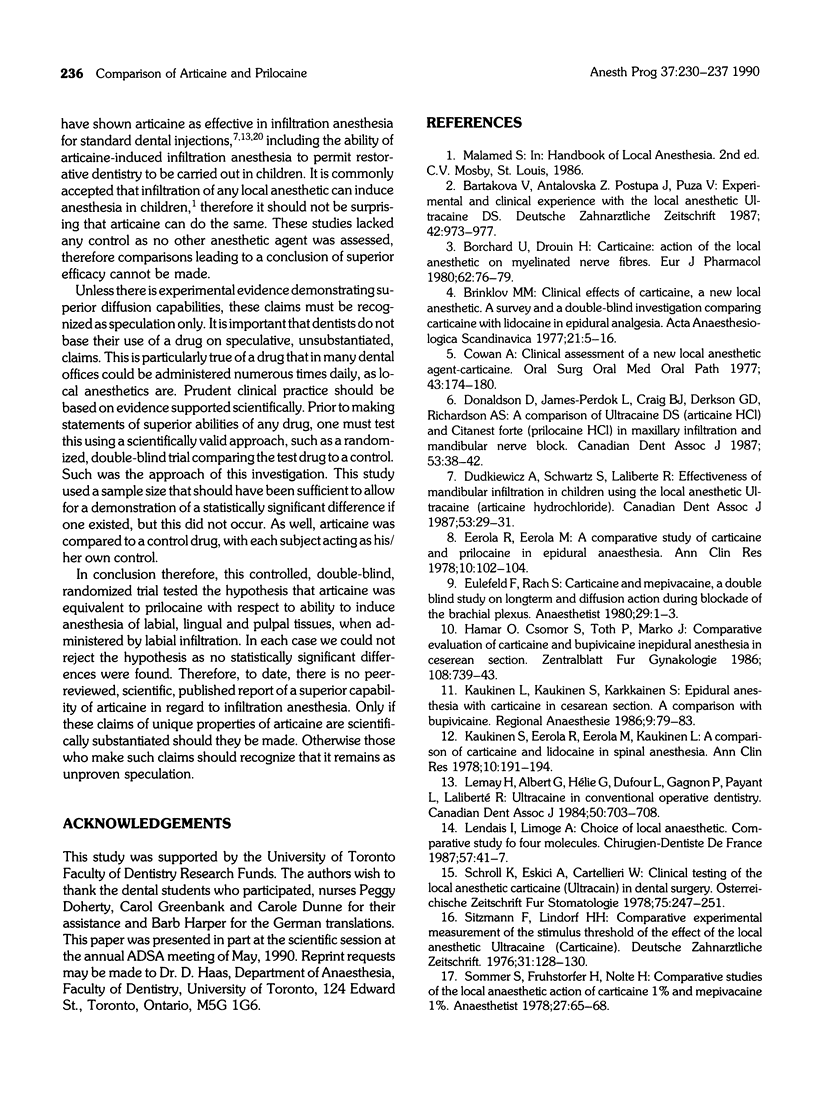

Selected References
These references are in PubMed. This may not be the complete list of references from this article.
- Borchard U., Drouin H. Carticaine: action of the local anesthetic on myelinated nerve fibres. Eur J Pharmacol. 1980 Mar 7;62(1):73–79. doi: 10.1016/0014-2999(80)90482-3. [DOI] [PubMed] [Google Scholar]
- Brinklov M. M. Clinical effects of carticaine, a new local anesthetic. A survey and a double-blind investigation comparing carticaine with lidocaine in epidural analgesia. Acta Anaesthesiol Scand. 1977;21(1):5–16. doi: 10.1111/j.1399-6576.1977.tb01186.x. [DOI] [PubMed] [Google Scholar]
- Cowan A. Clinical assessment of a new local anesthetic agent-carticaine. Oral Surg Oral Med Oral Pathol. 1977 Feb;43(2):174–180. doi: 10.1016/0030-4220(77)90153-0. [DOI] [PubMed] [Google Scholar]
- Donaldson D., James-Perdok L., Craig B. J., Derkson G. D., Richardson A. S. A comparison of Ultracaine DS (articaine HCl) and Citanest forte (prilocaine HCl) in maxillary infiltration and mandibular nerve block. J Can Dent Assoc. 1987 Jan;53(1):38–42. [PubMed] [Google Scholar]
- Dudkiewicz A., Schwartz S., Laliberté R. Effectiveness of mandibular infiltration in children using the local anesthetic Ultracaine (articaine hydrochloride). J Can Dent Assoc. 1987 Jan;53(1):29–31. [PubMed] [Google Scholar]
- Eerola R., Eerola M. A comparative study of carticaine and prilocaine in epidural anaesthesia. Ann Clin Res. 1978 Apr;10(2):102–104. [PubMed] [Google Scholar]
- Eulefeld F., Rach S. Carticain und Mepivacain Doppelblindstudie über Latenzzeit und Diffusionsverhalten bei der Blockade des Plexus brachialis. Anaesthesist. 1980 Jan;29(1):1–3. [PubMed] [Google Scholar]
- Kaukinen L., Kaukinen S., Kärkkäinen S. Epiduralanaesthesie mit Carticain bei Sectio caesarea. Ein Vergleich mit Bupivacain. Reg Anaesth. 1986 Jul;9(3):79–83. [PubMed] [Google Scholar]
- Kaukinen S., Eerola R., Eerola M., Kaukinen L. A comparison of carticaine and lidocaine in spinal anaesthesia. Ann Clin Res. 1978 Aug;10(4):191–194. [PubMed] [Google Scholar]
- Lemay H., Albert G., Hélie P., Dufour L., Gagnon P., Payant L., Laliberté R. Ultracaine en dentisterie opératoire conventionnelle. J Can Dent Assoc. 1984 Sep;50(9):703–708. [PubMed] [Google Scholar]
- Schroll K., Eskici A., Cartellieri W. Klinische Erprobung des Lokalanästhetikums Carticain (Ultracain) in der zahnärztlichen Chirurgie. Osterr Z Stomatol. 1978 Jul-Aug;75(7-8):247–251. [PubMed] [Google Scholar]
- Sitzmann F., Lindorf H. H. Vergleichende experimentelle Reizschwellenmessungen der Wirkung des Lokalanästhetikums Ultracain (Carticain) Dtsch Zahnarztl Z. 1976 Feb;31(2):128–130. [PubMed] [Google Scholar]
- Sommer S., Fruhstorfer H., Nolte H. Vergleichende Untersuchung über die Wirkung von Carticain 1% und Mepivacain 1%. Anaesthesist. 1978 Jul;27(7):65–68. [PubMed] [Google Scholar]
- Sonnabend E., Maschinski G. Tierexperimentelle Untersuchungen zur Toxizität von Carticain und Lidocain. Dtsch Zahnarztl Z. 1976 Feb;31(2):126–127. [PubMed] [Google Scholar]
- Winther J. E., Patirupanusara B. Evaluation of carticaine - a new local analgesic. Int J Oral Surg. 1974;3(6):422–427. doi: 10.1016/s0300-9785(74)80007-4. [DOI] [PubMed] [Google Scholar]
- Wright G. Z., Weinberger S. J., Friedman C. S., Plotzke O. B. Use of articaine local anesthesia in children under 4 years of age--a retrospective report. Anesth Prog. 1989 Nov-Dec;36(6):268–271. [PMC free article] [PubMed] [Google Scholar]
- Young E. R., Mason D. R., Saso M. A., Albert B. S. Some clinical properties of Octocaine 200 (2 per cent lidocaine with epinephrine 1:200,000). J Can Dent Assoc. 1989 Dec;55(12):987–991. [PubMed] [Google Scholar]


